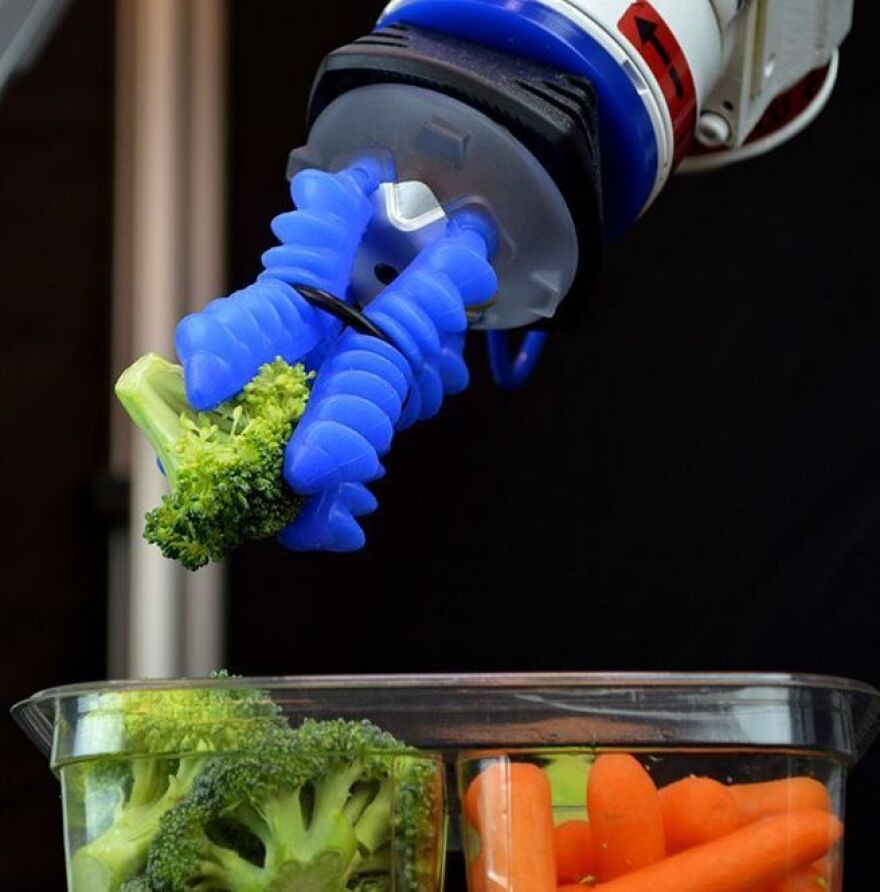Robotics researchers at Cornell University made a hand that has something close to a human touch — it can not only touch delicate items but also sense the shape and texture of what it comes into contact with.
Such a soft robot hand is a step forward for the growing field of soft robotics — the kind of technology that's already used in warehouses to handle food or other products. But it also holds promise for better prosthetics, robots to interact directly with people or with fragile objects, or robots to squeeze into tight spaces.
Think of a traditional robot and imagine its gripper. It would likely be made of rigid parts, powered by joints and motors. That's because in the past, for a robotic hand to sense what it's holding or touching, it had to be made of something that can conduct electricity, like metal.
Now, it just has to be something that can conduct light, says , a doctoral candidate in mechanical engineering at Cornell who is the lead author of the research articleabout the new soft robot hand, published this month in the journal Science Robotics.
"Our human hand is not functioning using motors to drive each of the joints; our human hand is soft with a lot of sensors ... on the surface and inside the hand," she says. "Soft robotics provides a chance to make a soft hand that is more close to a human hand."
Imagine a hand-shaped balloon, with light signals running through bendable so-called waveguides, pipes that carry waves, inside the fingers. When the hand touches something, the waveguides bend, distorting or changing the light signals. That change gives the robot data on whatever it is the hand is touching.
"There's a tremendous unmet need here," says Joshua Lessing, director of research and development at the company Soft Robotics that is already making products using soft robotics. The company's soft robot grippers are used in factories to sort and pack food like tomatoes or baked goods and to pick up things that people order online.

Researchers in Italy are using soft robotics to develop a better endoscope to travel inside human bodies, a soft arm for helping elderly people in the shower and physical models of vocal cords and lungs of preterm babies that can be used to train doctors.
Relying on light signals also means that robotic hands could be made with cheaper materials, which could lead to cheaper prosthetic hands that give the wearer a sense of touch, says Robert Shepherd, assistant professor of mechanical and aerospace engineering at Cornell who co-authored the study.
Zhao estimates her soft robotic hand could be made for under $50 — even less with mass production, though you'd need more money to add a battery and a compressor tank, for the compressed air that controls the robotic fingers. Shepherd says it's the cheapest product of its kind.
And this is where soft robot hands face one of the challenges. Soft robots need more energy just to maintain their shape, says Daniela Rus, a professor of electrical engineering and computer science at MIT.
"Drop your arm on the side of the chair and let it dangle. Imagine that arm as a soft robot — that is the rest state," she says. But if you want to move a soft robot arm and keep it in the air, say in a right angle with the hand pointing up — that requires energy to generate and keep the shape.
Another, more fundamental challenge, in getting to new, soft prosthetics is linking the robot hand to a human brain so that it can be operated naturally.
That work has long been underway, with some breakthroughs on more rigid prosthetics.
The Defense Advanced Research Projects Agency recently made a prosthetic hand directly connected to a paralyzed man's brain, which let him "feel" again.
Another article in Science Robotics describes a hand-brain interface that allowed six paraplegic people to move their hands again, picking up cups, holding forks, eating potato chips.
The soft robot hand at Cornell doesn't have a direct connection to the brain yet; rather, it lets a computer sense what a person might feel.Shepherd says his team, working on the soft robot hand, is looking for collaborators so they can improve the hand by testing it on humans.
Copyright 2021 NPR. To see more, visit https://www.npr.org. 9(MDAxNzg0MDExMDEyMTYyMjc1MDE3NGVmMw004))








